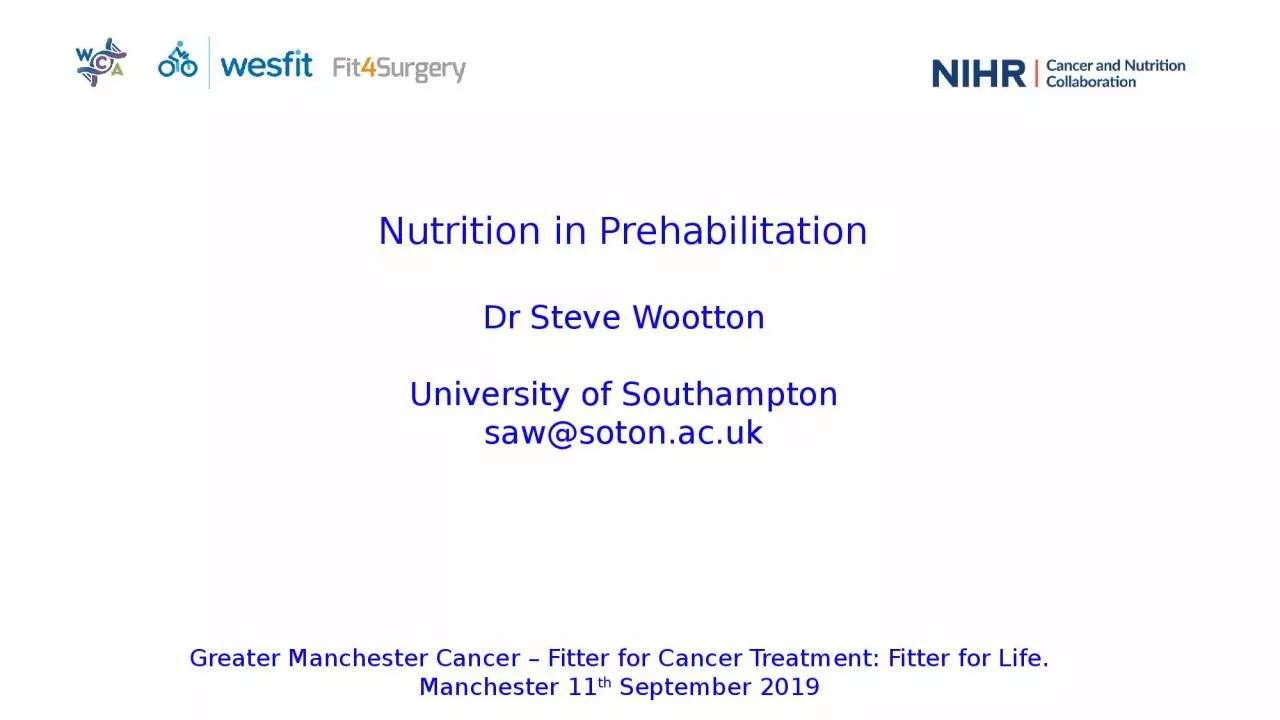

Dr Steve Wootton University of Southampton sawsotonacuk Greater Manchester Cancer Fitter for Cancer Treatment Fitter for Life Manchester 11 th September 2019 Malnutrition and weight loss ID: 1040925
Download Presentation The PPT/PDF document "Nutrition in Prehabilitation" is the property of its rightful owner. Permission is granted to download and print the materials on this web site for personal, non-commercial use only, and to display it on your personal computer provided you do not modify the materials and that you retain all copyright notices contained in the materials. By downloading content from our website, you accept the terms of this agreement.
1. Nutrition in PrehabilitationDr Steve WoottonUniversity of Southamptonsaw@soton.ac.ukGreater Manchester Cancer – Fitter for Cancer Treatment: Fitter for Life. Manchester 11th September 2019
2. Malnutrition and weight loss in cancer patients1. Halpern-Silveira D, et al. Support Care Cancer. 2010;18(5):617-625; 2. Laviano A, Mequid MM. Nutrition. 1996;12(5):358-371; 3. Bozzetti F. In: Payne-James J, Grimble G, Silk D, eds. Artificial Nutrition Support in Clinical Practice. 2nd ed. London: GMM; 639-680; 4. National Cancer Institute. Nutrition in Cancer Care.. 5. Dewys WD, et al. Am J Med 1980;69(4):491-7At cancer diagnosis, about 50% of patients present with some nutritional issues In certain cancers, up to 85% of patients will develop malnutrition/weight loss during treatmentInvoluntary weight loss of just 5% results in decreased survival, more complications, longer stay, & poor QoL.Most common secondary diagnosisfor cancer patients is malnutrition
3. Inadequate FoodConsumptionWastingReductive AdaptationInfectionstress traumaSpecific nutrient losses, cellular damage,tissue malfunction Loss of regulation & controlPhysiologically & metabolically unfitBeing undernourished matters !
4. Treatment-related side effects matter ! SymptomChemoRadiationSurgeryWeight lossFatigueNausea/VomitingTaste alterationsOral mucositisConstipationDiarrheaDry mouthLoss of appetiteAll impact on intake = impact on nutritional state
5. More symptoms, more undernourishment Isenring E, et al. Nutr Cancer. 2010;62(2):220-228.Number of SymptomsMedical Oncology Patients (N=191)Percentage of patients who are malnourished
6. Prado M et al. Lancet Oncol 2008; 9, 629-35Normal weight and compositionNormal weight but saropenic obeseMore than just weight, body composition matters.Prevalence & clinical implications of sarcopenic obesity in patients with solid tumours of the respiratory & gastrointestinal tracts: a population-based study.
7. LMartin et al. JCO 2013;31:1539-1547Prognostic variables:Sarcopaenia Low muscle attenuation (myosteatosis)> 8% weight lossAdditive effects of prognostic body composition variables on overall survivalOverweightObesePatients with sarcopenia, weight loss, poor muscle quality survived 8.4 months regardless of their presenting weight (cf those with no features who survived 28.4 months)
8. Phase angle as a prognostic marker of survival in advanced colorectal cancer. Gupta et al. AJCN 2004; 80; 1634-8
9. Lots of Guidance, - lacks evidence
10. Stratton & Elia Eur J Gastroent Hepatol 2007; 19, 353-8Calculated net savings with ONS based on LOSImproved outcomes in GI surgeryLower mortality (OR 0.59 0.48-0.72)Fewer postop complicationsShorter LOS Earlier return of GI functionLower rate of re-operationsAttenuates gut permeabilityImproved wound healingLess PN use
11. Screening all for riskAssessing status- Make a diagnosisSupported self managementAdviceCommunity-based careFacility-based careManage Co-morbidity +NEEDS-BASED PREHABILITATIONImplementation within health systemWork force development – capability & capacityDeveloping UK wide principles and guidance for prehabilitation in oncology – evidence domains
12. Evidence summary (2009-2018) - nutritional care 83 primary studiesInterventionAdvice onlyDiet + ONSImmuno ONSANS - tubeANS - PNNumber of papers 5 23 (5 PUFA) 40 7 9Site GastroH & Neck Liver LungBladderGyneaProstateHaematn 55 12 5 4 3 2 1 1SiteGI / ColorectalUrologicaln 14 1Evidence summary (2009-2018) – Systematic reviews 15 reviewsEvidence Synthesis dataset available at Macmillan.org.uk
13. Identifying patients at nutritional risk Low BMI (<18.5 kg/ht2)Weight Loss (>10% over 6/12)Poor food intake (<50% EAR) Markers of inflammation & infection (eg albumin <3g/dl) Screening (All)Assessment (Expert)Dietetic assessment of feeding and intakeDietary Impact Factors…Anthropometry, body composition & functionMicronutrient statusAssessment of requirementsHighest RiskLowest RiskMarkers of iron deficiency:serum ferritin (<30ug/l; or 100ug/l if inflammation (CRP >5mg/l) or transferrin saturation <20%)
14. Supportive, self-careAdvice [Home-based, remote support]Dietetic counselling + ONS Address dietary impact factors[Community-based, Out Patient]Artificial Nutritional SupportComplex needs & careNutrition Support Teams (IF Teams)[Hospital-based, In Patient]Personalised Care in Prehab – NutritionIncreasing risk
15. Dietary Impact FactorsDysphagiaNausea & vomitingMucositisTaste & smellAnorexiaMaldigestionMalabsorptionNutritional AssessmentWeightBody compositionAppetiteEating historySupplementsOther considerationsAnxiety about foodBeliefs, culture, faith‘Dr Google’Co-morbiditiesEducationSocio-economicDietetic counselling – assessment & prescription
16. Dietetic counselling - nutritional care Addressing Dietary Impact Factors-/+ supplementsMuch more than simply giving a high-protein supplement !UnderstandingEnablingConfidence
17. LeadershipTrainingSupportFidelityNutritional support – who leads, who delivers… ?
18. Nutritional within multimodal prehabilitation Length of StayGillis et al. Gastroenterology 2018; 155; 391-4102d reduction in LOS Nutrition-onlyMultimodal
19. Future prioritiesare all screening tools equally sensitive and specific in all cancer sites (eg cachectic v higher BMI cancers) ?who/how to assess nutritional state (especially lean/muscle mass and other biomarkers)?how to routinely incorporate screening & nutritional assessment into a prehab pathway ?who is going to deliver nutritional interventions & how universal, targeted, specialist ?
20. Special thanksNIHR Cancer & Nutrition CollaborationMacmillan Cancer Care & Royal College of AnaesthetistsMacmillan Review Nutritional Support working groupColleagues at SouthamptonClinical Nutrition GroupNutrition Support Team & Intestinal Failure UnitDietetic colleaguesPrehabilitation Medicine Team & Fit4Surgery School Team
21.
22. Research priorities – nutritional interventionkey goals of preop nutritional care nutritionally sensitive and specific markers of efficacydelivering remote counselling (web-based or app) & adherenceevidence that dietetic counselling, ONS, high Protein ONS, Immunonutrition, & PN in prehab improves nutritional state & clinical outcomes?barriers/facilitators to meeting the nutritional needs of the patient?service delivery implications to embedding nutritional care into a prehab service?health economic costs of nutritional care in prehab